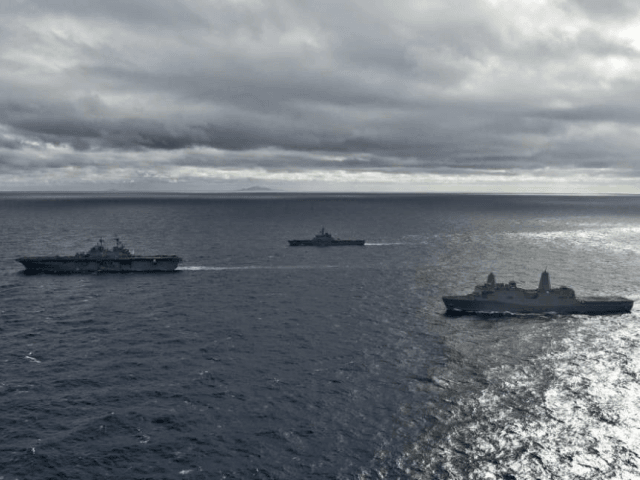The U.S. military has documented a “surge of maritime activity” by China in the South China Sea and the East China Sea since the coronavirus pandemic began, indicating that Beijing has been capitalizing on the global distraction caused by the crisis to bolster its illegal claims to territory in the waters, Reuters reported on Friday.
“Through the course of the COVID [Chinese coronavirus] crisis we saw a surge of maritime activity,” U.S. Air Force Lieutenant Gen. Kevin Schneider told Reuters in a phone interview. The commander of U.S. forces in Japan said Chinese coast guard vessels, navy ships, and a naval militia of fishing boats in harassing vessels have been sighted in waters claimed by Beijing in the South China Sea. Schneider added that Beijing had also increased its activity in the East China Sea, where it remains engaged in a territorial dispute with Japan.
Schneider expects Beijing’s increased maritime activity to continue for the foreseeable future. “I don’t see troughs, I see plateaus,” he said.
Home to the biggest concentration of U.S. military forces in Asia, Japan supports the U.S. presence in the region as a key ally. The island nation hosts major forces of U.S. military might, including an aircraft carrier strike group, an amphibious expeditionary force, and fighter squadrons, Reuters noted. These units defend Japan but also serve to caution China against encroaching on other countries’ sovereign territory in the region, especially in the South China Sea.
The U.S. and Japan have continued to hold joint military exercises throughout the coronavirus pandemic, with the latest drill held on May 27; it was the third such drill held since April, the Nikkei reported. The U.S. military believes the exercises are important to counter Beijing’s aggression in the region.
“This mission is a demonstration … that we have the ability to operate from numerous locations across the globe, even during the global pandemic,” Gen. Tim Ray, commander of the U.S. Air Force Global Strike Command, said after a joint military drill with Japan in late April, according to the report. As part of the drill, a B-1 Lancer heavy bomber flew from the contiguous U.S. to Japan, where it then teamed with Japanese fighter jets.
During the latest joint drill on May 27, two B-1 bombers from the U.S. Air Force and 16 F-15 and F-2 fighter jets from Japan’s Air Self-Defense Force held exercises near the Japanese island of Okinawa and over the Sea of Japan, according to the Nikkei.
“These are very important as we further strengthen the deterrence and capabilities of Japan and the U.S. acting jointly,” said Gen. Yoshinari Marumo, chief of staff for Japan’s Air Self-Defense Force.
On April 6, the U.S. State Department condemned Beijing’s ramped up aggression in the South China Sea during the coronavirus pandemic in an official statement.
“We call on the PRC [People’s Republic of China] to remain focused on supporting international efforts to combat the global pandemic and to stop exploiting the distraction or vulnerability of other states to expand its unlawful claims in the South China Sea,” U.S. State Department spokeswoman Morgan Ortagus said.
The statement addressed China’s recent attacks on Vietnam in the South China Sea, including the hitting and sinking of a Vietnamese fishing boat in Vietnamese waters in April. In recent months, Vietnam has faced increased aggression from Beijing in the contested waterway, along with other southeast Asian nations such as Malaysia, Taiwan, and the Philippines. Despite an international court ruling in 2016 declaring China’s claims to the sea unlawful, China continues to assert authority over almost the entire South China Sea, considered highly valuable for its natural resources, strategic trade routes, and geopolitical importance.

COMMENTS
Please let us know if you're having issues with commenting.